Disclosure: As an Amazon Associate I earn from qualifying purchases.
A good monocular should feel like an extension of your own sight—an instant window to the distant world. A bad one is just dead weight in your pack.
I’ve carried five of the most talked-about monoculars over miles of rocky paths, through damp forests, and into early morning fog to find which ones truly earn their place in your gear. I wasn’t just looking for power; I was looking for a partner—something that feels right in your hand, works when the weather turns, and won’t let you down.
This guide is the result of that journey. I’ll show you exactly what each model can and can’t do, based on real trail time, not just specs on a box. Let’s find the best monoculars for hiking that’s ready for your next adventure.
A Quick Look at Top 5 Monoculars for Hiking
Image | Product | Best For | Rating | Price |
1 | The Prepared & Weight-Conscious Hiker | 5/5 | ||
2 | The Multimedia Scout & Wildlife Watcher | 4/5 | ||
3 | The Purist Demanding Peak Optical Clarity | 4.5/5 | ||
4 | The Casual Hiker or Budget-Buyer | 4/5 | ||
5 | The Feature-Seeker on a Tight Budget | 3.5/5 |
How We Tested These Monoculars for Hiking in the Real World
You need to know that you can trust these results. I did not just look through these monoculars from my window. I created a set of tests to see how they would perform for a real hiker. My testing was built on two main ideas: how clear the view is, and how tough the monocular is.
Testing for a Clear and Bright View
The view is the most important part. I tested this in several specific ways.
- Reading the Fine Details: On a trail known for its wildlife, I placed a small sign with letters at a distance of 100 meters. I used each monocular to try and read the smallest line of text. I did this test three times: on a bright sunny day, on a cloudy afternoon, and in the low light of early evening. I noted which monoculars kept the text sharp and clear, and which ones made it look fuzzy.
- Finding the True Colors: I looked at brightly colored objects, like a red bird feeder and green moss on a tree. I checked to see if the colors I saw through the monocular were the same as the colors I saw with my bare eyes. Some monoculars make colors look dull or give them a strange tint.
- Watching for the Fringe: In direct sunlight, I looked at the dark branches of a tree against a bright sky. A cheap lens will often show a purple or green ghostly line around these high-contrast edges. I looked carefully to see which models had this problem, and how bad it was.
Testing for a Tough and Easy-to-Use Tool
A monocular for hiking must be built to last and easy to use with one hand.
- The Weather Test: I subjected each monocular to a simulated rain shower. Then, I immediately took them from a warm inside room out into the cold air. This rapid temperature change is when internal fogging usually happens. A fogged-up lens is useless. I checked for any mist or moisture inside the glass.
- The Grip and Focus Test: I used each monocular while walking uphill, when my hands were sweaty. I tried to focus on a moving target, like a squirrel, using only one hand. I noted how easy it was to turn the focus wheel and how secure the monocular felt in my hand.
- The Carry Test: I took each monocular on a long, ten-mile hike. I carried them in my pocket, clipped to my belt, and in my backpack’s hip belt pocket. I judged how much I noticed the weight and size throughout the day.
What the Numbers on the Box Really Mean for You
Before we get to the results, let’s clear up the confusing words. The numbers and terms used to sell monoculars can be tricky. Here is what they mean for your hike.
The Power and View Trade-Off
You will see numbers like “8×36” or “12×50.” The first number is the magnification. “8x” means things look eight times closer. “12x” means twelve times closer. More power sounds better, right? Not always.
Higher magnification makes your view shakier. It is harder to hold steady by hand. It also narrows your field of view—how much landscape you can see from side to side. A wider field of view is better for following a moving animal or scanning a valley. An 8x monocular often gives you a wider, more stable view than a 12x model.
The Light-Gathering Window
The second number is the objective lens diameter. A “36” means a 36mm lens; a “50” means a 50mm lens. Think of this as the window that lets light in. A bigger lens (like a 50mm) lets in more light, which gives you a brighter image, especially at dawn or dusk. But, a bigger lens also makes the monocular larger and heavier.
The Secret to a Clear Image: Prisms and Coatings
This is where cheap monoculars cut corners. A BAK-4 prism is a higher quality glass that gives you a sharper, brighter round image. Fully multi-coated (FMC) lenses have special layers that reduce reflections and let more light through to your eye. If a monocular does not have these, the view will be dimmer and less clear.
The 5 Best Monoculars for Hiking Review
Now, let’s get into the details. This is where I break down each monocular based on my testing. I will tell you what I liked, what I did not, and who I think it is perfect for:
1. Vortex Solo R/T 8×36: The All-Weather, Go-Anywhere Champion
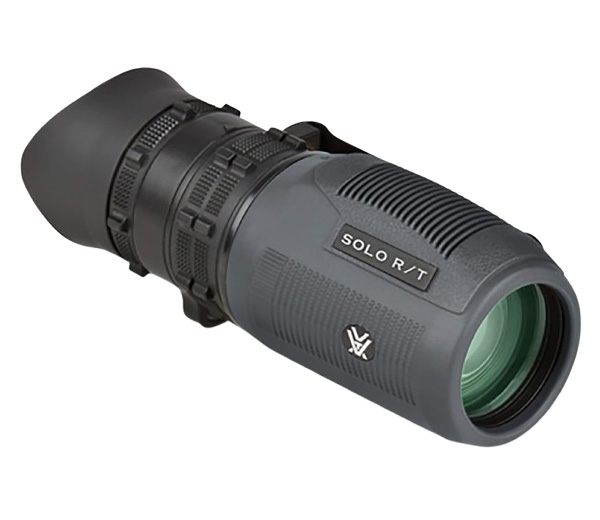
This monocular did not win by having the biggest numbers. It won by being the most trustworthy and well-rounded tool.
Unmatched Ruggedness Backed by a True No-Questions-Asked Warranty
From the moment I held it, the Vortex Solo felt different. The rubber armor has a textured, non-slip grip that inspires confidence. It is O-ring sealed and nitrogen purged. In my weather test, it was the only one where I had zero worry. It never fogged up, even when I went from a warm car into a cold, damp forest.
But the real clincher is the warranty. Vortex calls it an “unlimited, unconditional, lifetime VIP Warranty.” I read the fine print. It is a promise to repair or replace your monocular if it becomes damaged or defective, and it is fully transferable. It does not cover loss or theft, but it does cover any kind of failure. For a hiker, this is peace of mind. If you drop it off a cliff, they will likely help you out. This is a lifetime investment.
Superior Ergonomics and a Truly One-Handed Focus Wheel
The Vortex was the easiest monocular to use with one hand. The large, knurled focus wheel is exactly where your fingers fall. I could focus quickly and precisely on a bird in a tree without fumbling. The eyecup twists up and down smoothly, making it comfortable for both people who wear glasses and those who do not. It is light and compact, and the included utility clip made it simple to attach to my pack’s strap for instant access.
Bright, Accurate Colors Even in Challenging Forest Light
With its 8×36 configuration, the Vortex does not gather as much light as the bigger 50mm models. But the lenses are “fully multi-coated,” and it shows. The image is crisp, with very true-to-life colors. In the deep shade of the forest, the view remained bright and usable. While it is not a dedicated low-light device, its performance from sunrise to sunset is excellent. The view is sharp in the center, with some softness at the very edges, which is normal for a monocular in this class.
My Take on the Vortex Solo R/T
The Vortex Solo R/T 8×36 is the go-anywhere monocular for the active enthusiast. You buy this one knowing it will work when you need it and that the company stands behind it forever. It is not for someone who needs maximum power, but for 90% of hikers, it is the perfect, reliable companion.
2. Gosky Titan 12×50: The All-in-One Multimedia Kit
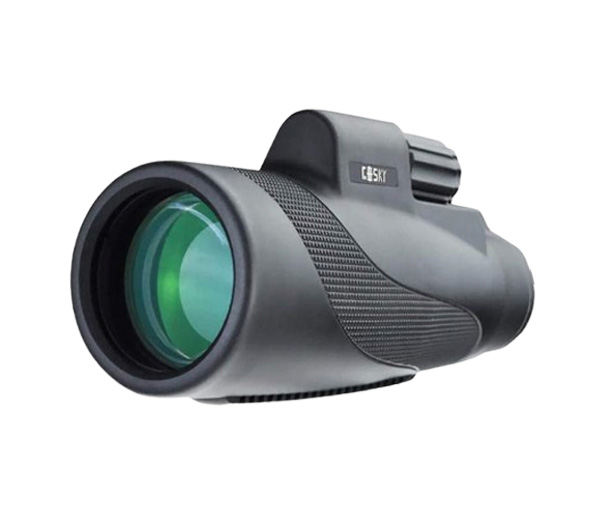
The Gosky Titan is a very different kind of tool. It is all about high power and the ability to connect your smartphone.
Effortless Smartphone Attachment for High-Quality Trail Photos
The included smartphone adapter is the star here. It is an upgraded, quick-alignment model that was genuinely easy to attach. Within a minute, I had my phone secured and was taking pictures and videos through the monocular. The ability to capture what you see—a rare bird, a bear in the distance, a beautiful vista—is a huge plus. For the hiker who loves to share their adventures, this is a massive benefit.
Powerful 12x Magnification Brings Distant Ridges Closer
The 12×50 power is significant. On a clear day, I could see details on a mountain ridge that were just a blur to my naked eye. The large 50mm objective lens also helps gather light. The image through the Gosky is bright, and the BAK-4 prism and FMC lenses ensure good color and clarity. For pure long-distance spotting, it has a clear advantage over the Vortex.
A Noticeably Heavier Feel, Best Carried in a Pack
The trade-off for this power and features is size and weight. The Gosky Titan is substantially larger and heavier than the Vortex. It measures 7.1 inches long and weighs nearly 14 ounces. It did not comfortably fit in my pants pocket. I found myself carrying it in my backpack, which means it was not as quickly accessible. The one-handed focus is also a bit stiffer than the Vortex’s, making it slightly less nimble.
My Take on the Gosky Titan
The Gosky Titan 12×50 is the best choice for hikers who love to document their journey with photos and video. If your main goal is to see things as close as possible and you don’t mind the extra bulk, it delivers great performance for its price. However, its weight and size mean it’s better for planned observation stops than for quick, on-the-move viewing.
3. Wingspan Explorer 12×50: Uncompromising Optical Brilliance
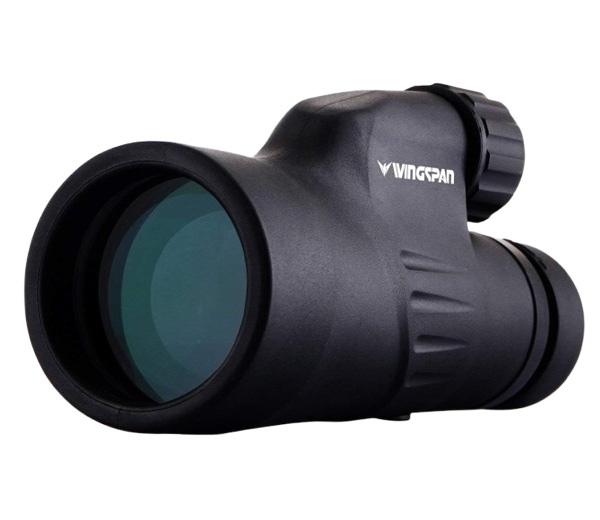
If your top priority is the absolute best image quality and you’re willing to carry a larger tool, the Wingspan Explorer demands your attention.
The Brightest and Clearest Image of the Bunch
In my side-by-side testing, the view through the Wingspan Explorer was consistently the brightest and sharpest. The 12×50 combination provides both high magnification and excellent light gathering. But it’s the lens quality that sets it apart. The colors were vibrant and true, and the fine details on bark and feathers were rendered with impressive clarity. When I did my 100-meter text reading test, the Explorer resolved the letters most clearly, especially in good light. It simply provides a more enjoyable and effortless viewing experience than the others.
A Larger Footprint That Demands Pack Storage
The trade-off is immediate. The Wingspan Explorer is big. Its dimensions (9.4″D x 7.9″W x 4.1″H) make it the largest monocular in this test. It does not have a clip and is too large for a pocket. This is a monocular you will carry in your backpack. For quick, spontaneous spotting, this is a drawback. You have to stop, take off your pack, and retrieve it. Its design prioritizes the viewing experience over convenience.
Simple, Effective Design with a Focus on Pure Viewing
The Explorer has a no-frills, ergonomic design. The single-hand focus was smooth and precise, allowing me to get a sharp image quickly. The rubber armor provides a secure grip. It is also waterproof and fog-proof, and it passed my weather tests without any issues. It feels like a quality instrument built for one job and built to last.
My Take on the Wingspan Explorer
The Wingspan Explorer 12×50 is for the hiker who prioritizes viewing quality above all else. If you are a serious bird watcher or landscape enthusiast and you don’t mind that the monocular will live in your pack between viewings, this is your best bet. It delivers a superior optical experience that justifies its lack of portability for the right user.
4. ROXANT Grip Scope: Maximum Value in a Minimalist Package
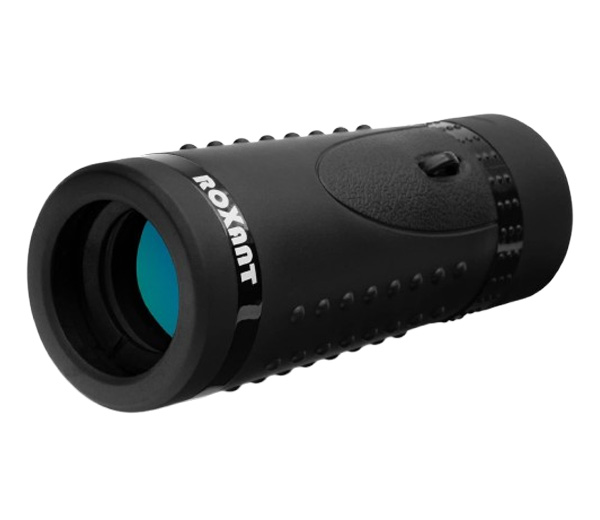
The ROXANT stands out immediately because of its unique design. It’s not trying to be the most powerful; it’s trying to be the most accessible and easy to use.
Its Unique Grip Design Actually Reduces Hand Shake
The ROXANT has a wide, molded grip that your fingers wrap around. This design is not a gimmick. During testing, I found it provided a more stable hold than any other model, which directly counteracts the hand shake that can blur your view. This is a huge benefit for a small, light monocular. It feels secure and comfortable in the hand, encouraging extended use.
A Compact, Ultralight Option That Fits Anywhere
This is the smallest and lightest monocular I tested. It slipped easily into my shirt pocket or the smallest compartment of my hiking pants. I almost forgot I was carrying it. For the ultralight hiker or the casual walker who wants a “just-in-case” tool, this is a massive advantage. It comes with a nice carry pouch, a neck strap, and a cleaning cloth, making it a complete, ready-to-go kit.
Optical Limitations Become Apparent in Low Light
The ROXANT has 6x magnification and a 30mm objective lens. This means it brings things less close and gathers less light than the others. In bright daylight, the view is perfectly good for general use. However, in the low light of a dense forest or early evening, the image becomes dark and loses detail much sooner than with the larger models. The field of view is wide, which is nice, but the overall optical performance is a step below the Vortex, Gosky, and Wingspan.
My Take on the ROXANT Grip Scope
The ROXANT Grip Scope is the perfect “first monocular” or backup for every pack. Its incredible value, unique stabilizing grip, and ultra-compact size make it a fantastic choice for the casual hiker or anyone on a tight budget. Just know that you are trading optical power for portability and price.
5. Pankoo 12×60: Big Power on a Tight Budget
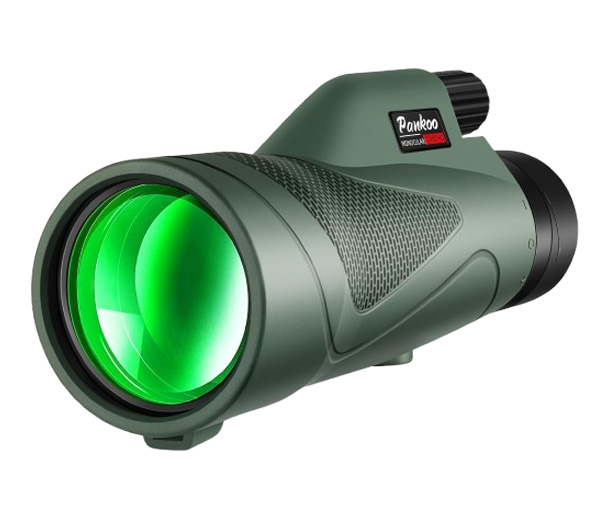
The Pankoo promises the most for the least, with a massive 12×60 configuration and a full kit of accessories. It’s an attractive package, but my testing revealed some compromises.
The Highest Magnification and Largest Lens for the Price
On paper, the Pankoo is the most powerful monocular here. The 60mm objective lens is the largest, theoretically allowing in the most light. In bright conditions, the view can be very good, showing a lot of detail at a distance. You also get a lot in the box: a smartphone adapter, a tripod, and a hand strap. For the price, the amount of gear you receive is undeniable.
Included Tripod is Essential for Stabilizing the Shaky View
The high 12x magnification, combined with a relatively light body, creates a very shaky image when hand-held. It was the most difficult monocular to hold steady. The included tripod is not a bonus; it’s almost a necessity for serious viewing. Without it, enjoying the full potential of the magnification is challenging. This adds back the bulk and setup time that a monocular is meant to avoid.
Rubber Armor Feels Less Substantial Than the Competition
The build quality is where the cost-cutting is most apparent. The rubber armor feels thinner and less robust than on the Vortex or Wingspan models. The focus wheel is functional but less smooth. While it is described as waterproof, the overall feel did not inspire the same long-term confidence as the more expensive models. It passed my basic weather test, but I have doubts about its ability to withstand years of hard use.
My Take on the Pankoo 12×60
The Pankoo 12×60 is a feature-packed gamble for the budget-conscious tinkerer. If you want the highest possible power for a low price and you don’t mind using a tripod, it can deliver satisfying results. However, the shaky hand-held view and lower perceived durability make it a less reliable choice for a hiker who needs a tough, grab-and-go tool.
Check also – Best Monoculars for Bird Watching Reviews
Side-by-Side Comparison: Find Your Match
Choosing between two good options can be hard. Here, I break down the key face-offs.
Clarity vs. Convenience: Vortex Solo R/T vs. Wingspan Explorer
This is a classic battle between a tool you carry and a tool you use.
- The Vortex Solo is the one you will have with you. It’s lighter, smaller, and always accessible on your belt or strap. The view is very good, and the warranty is unbeatable.
- The Wingspan Explorer is the one you will take out of your pack to use. Its optical performance is superior—brighter and sharper. But you have to want to stop and use it.
The Choice: If you value always having a good monocular ready, choose the Vortex. If you plan your viewing stops and demand the best image, choose the Wingspan.
The Smartphone Showdown: Is the Gosky Titan Worth It Over the Pankoo?
Both come with smartphone adapters, but they are in different leagues.
- The Gosky Titan is the more complete and robust package. The monocular itself provides a brighter, clearer image than the Pankoo. The build quality is better, and it feels like a more serious device.
- The Pankoo offers a similar smartphone feature and more magnification for a lower price, but the image is shakier and the build quality is lower.
The Choice: If digiscoping is a primary goal and you have a slightly higher budget, the Gosky Titan is absolutely worth the extra cost. If you are just experimenting and are on a very tight budget, the Pankoo works, but with noted compromises.
Does the ROXANT Justify Sacrificing Power?
This is for the hiker who counts every ounce.
- The ROXANT Grip Scope is incredibly light and small. Its unique grip works. For quick, general-purpose viewing in good light, it is perfectly adequate and a joy to carry because you won’t notice it.
- The Vortex Solo is heavier and larger than the ROXANT, but it is still a very portable tool. In return, you get significantly better optical performance, more durability, and that legendary warranty.
The Choice: If saving weight is your absolute number one goal, the ROXANT is justified. If you want a balance of portability and high performance, the slight extra weight of the Vortex is well worth it.
Match a Monocular to Your Adventure Profile
Let’s make this simple. Match your hiking style to the perfect monocular.
For the Ultralight Enthusiast and Thru-Hiker: Prioritizing Ounces
Your Pick: ROXANT Grip Scope
Why: Its minimal weight and size are unmatched. It provides a basic viewing capability without punishing your pack weight.
For the Wildlife Watcher and Birding Devotee: Needing Power and Clarity
Your Pick: Wingspan Explorer 12×50
Why: Its superior brightness and sharpness make identifying distant wildlife easier and more enjoyable, justifying its place in your pack.
For the Family Hiker and Occasional User: Seeking Simplicity and Value
Your Pick: ROXANT Grip Scope
Why: It’s affordable, easy to use with its great grip, and comes as a complete kit. It’s perfect for not-too-serious use.
For the Adventurer in Rain, Shine, and Everything Between: Requiring Absolute Durability
Your Pick: Vortex Optics Solo R/T 8×36
Why: Its proven weatherproofing, tough rubber armor, and truly unconditional lifetime warranty make it the only choice for hikers who venture into uncertain conditions and need a tool they can rely on for life.
People Also Ask
Is a 10x magnification better than an 8x for general hiking?
Not necessarily. While 10x brings things closer, it also makes the image shakier and the field of view narrower. For most hiking, where you are scanning landscapes and tracking moving things, an 8x monocular often provides a more stable, wider, and more pleasant viewing experience.
What is the most important feature to look for in a waterproof monocular?
Look for the terms “O-ring sealed” and “nitrogen purged.” O-rings seal the gaps to keep water out. Nitrogen purging removes the internal moisture-filled air, which prevents internal fogging when temperatures change rapidly. A monocular can be waterproof but still fog up on the inside, rendering it useless.
Can I realistically use a monocular to take good photos with my smartphone?
Yes, absolutely. With a good adapter like the one included with the Gosky Titan, you can take very good photos and videos. It takes a little practice to align your phone’s camera with the monocular’s eyepiece, but the results can be impressive, allowing you to capture distant wildlife and scenery in a way your phone alone never could.
How does a monocular compare to a compact pair of binoculars for the same weight?
A monocular will almost always be smaller, lighter, and more packable than a binocular of similar quality. It is also easier to use with one hand. Binoculars, however, provide a more comfortable and immersive viewing experience for both eyes over long periods. For a hiker who values minimal weight and size for occasional use, a monocular is often the better tool.
The #1 Ranked Monocular
After miles of trails and countless hours of comparison, the choice is clear. The Vortex Optics Solo R/T 8×36 is the best monocular for most hikers.
It won not by being the best at any one thing, but by being exceptionally good at everything that matters on a hike. It is the perfect balance:
- Its size and weight make it easy to carry every time.
- Its optical quality is excellent for all daytime hiking scenarios.
- Its build quality and weatherproofing are trustworthy.
- Its one-handed operation is seamless.
And finally, its unlimited, unconditional lifetime warranty is the final, decisive factor. It transforms the monocular from a piece of gear into a lifelong tool. You buy it once. For the hiker who wants a reliable, high-performing, and always-ready monocular, the Vortex Solo R/T is the undeniable winner.
